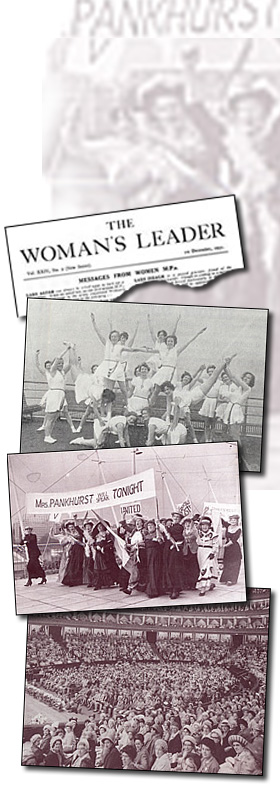
1929
The first Townswomen's Guild was formed in Hayward's Heath, quickly followed by Burnt Oak, Moulsecoomb and Romsey - by the end of the year 26 Guilds had been formed.
1930
Federations had been established to enable Guilds in close proximity to know and help each other. The organisation changed its name to the National Union of Townswomen's Guilds (NUTG) and adopted the NUWSS (National Union of Women's Suffrage Societies) colours - red for courage, white for faith and green for hope. The national membership magazine became known as the 'Townswoman' changing its name from the 'Women's Leader'.
1940
Guilds continued to meet during the war, staging shows and concerts to boost morale. Married women within the NUTG, ineligible for National Service, were encouraged to work in offices, shops and local industries to release men and women for munitions and services. After the war, the NUTG received a grant from the Ministry of Education to develop the movement and strengthen its educational base.
1950
The Festival of Britain gave Guilds and Federations an opportunity to celebrate. Resolutions were passed at the 1953 National Council Meeting (NCM) to allow townswomen to campaign on national affairs. The 25th anniversary (1954) was marked by a pageant entitled 'With this Sword' performed in the newly built Royal Festival Hall. In 1959, Townswomen's Guilds marked World Refugee Year by raising funds to help clear a refugee camp at Ried, Austria.
1960
In 1961 the clearing of Ried camp was completed and Townswomen helped raise more than £48,000 to build four blocks of flats for the refugees. By the end of the 1960s the total number of Guilds had risen to 2,700. The 40th anniversary was celebrated at the Royal Albert Hall by a performance of 'The Miracle' - a mime set to music by Humperdink.
1970
The National Chairman's new chain of office, designed by Leslie Durbin, was worn for the first time. Her Majesty the Queen became Townswomen's Guilds patron for its Jubilee Year followed by HRH The Princess Royal who attended the Golden Anniversary Lunch held at the Savoy.
1980
The end of an era came with the death of Dame Margery Corbett Ashby, aged 99 years. Her link with the movement had remained strong since its formation. To celebrate the Diamond Jubilee a tapestry was designed by the Royal School of Needlework, with the surrounding panels stitched by Guild members. A gala concert at Central Hall, Westminster was attended by HRH The Princess Royal who also joined members at a special reception in November 1988.
1990
The decade ended with a service at held at St. Martin-in-the-Fields, London remembering the founders and members from the past as the organisation looked towards the new century.
The Millennium
In celebration of the Millennium, Townswomen from across the UK came together at the Royal Albert Hall to perform 'Circles of Time' - an evening of song, dance, narration and movement to celebrate the decades of time, seasons and civilisations. In 2002, over 300 Townswomen put on their finery to celebrate the Queen's Golden Jubilee in the company of HRH The Princess Royal at the breathtaking Botanical Gardens in Birmingham.
Today
There are nearly 500 Guilds throughout England, Scotland, Wales, Northern Ireland and the Isle of Man. Townswomen are encouraged to have ideas and views, develop new skills, campaign on various issues, support each other, make new friends and above all have fun!
For Townswomen's full history, please see our History Sheet - History Sheet